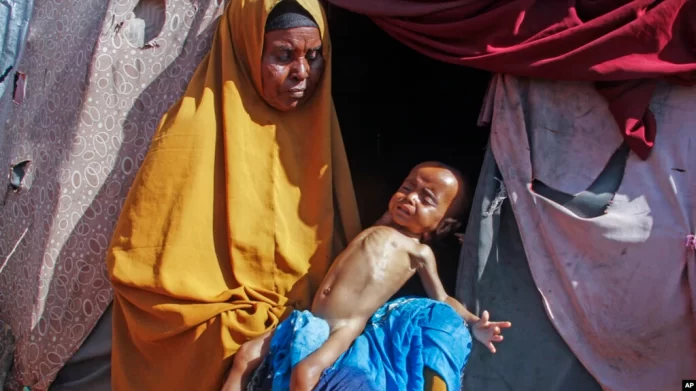BAIDOA, SOMALIA — Somalia is in the middle of its worst drought in decades, with millions of people in need of aid and thousands on the brink of starvation. The United Nations estimates 4.3 million Somalis are affected by the drought and more than half-a-million displaced.
Baidoa already hosts over 400,000 internally displaced Somalis but more people affected by drought are flocking to the town every day in search of food, water, and shelter.
Somalia’s Southwest State is one of the areas worst hit by a record drought not seen in decades.
Forty-seven-year-old Ali Adan Hassan’s livestock died in the drought, and in late February his family of seven ran out of food.
A blockade by al-Shabaab insurgents made it impossible for aid to reach his district in the Bakok region. So Hassan set out on foot to Baidoa, a journey that took two weeks.
He said his family didn’t have a car or money to pay for a donkey cart, so they trekked more than 200 kilometer for 15 days to reach Baidoa. During the journey, he said, his wife and 3-year-old child died from hunger and thirst. He had to bury them along the way.
Baidoa is battling water shortages and an influx of villagers like Hassan, fleeing drought and starvation.
Single mother Mumino Moalim Osman, 40, lives in one of the Baidoa’s internally displaced persons camps with her 10 children. Her husband died seven years ago.
She told VOA they arrived in late February after walking for two weeks from Bokoro village.
They had a mother camel for milk, said Osman, but it died and only the baby camel remains.
She feeds the baby camel the same tea she gives her children, said Osman. The camel is her life, said Osman, and it must survive.
Adan Farah is an adviser for U.K.-based aid group Save the Children. She told VOA millions of Somalis are in dire need.
“According to rapid needs assessment conducted by Save the Children, 3.9 million people across Somalia are not able to access food, in which 1.8 million people are facing severe food insecurity,” she said. “The ongoing drought has plunged the majority of the population into food insecurity. The key drivers of acute food insecurity in Somalia include the combined effects of consecutive seasons of poor and erratic rainfall distribution and conflict.”
Daud Adan Jiran, Somalia director for the U.S.-based aid group Mercy Corps, recently visited Baidoa and met with displaced families.
“Somalia’s situation is deteriorating,” he said. “There is a severe water and food shortage. Most of these communities’ primary source of income is livestock, which has died. Crops have failed, so there is no food. Families have depleted what little reserves they had. If we don’t get rain in April, we may be on the verge of a repeat of the 2011 famine disaster.”
The U.N. says the 2010-12 famine, at the time the first in nearly a decade, killed a quarter-million Somalis, half of them children under the age of 5.
Baidoa community activists Nadeef Abdishakur Mohamed told VOA there is still time to prevent another famine.
“The government and humanitarian agencies must act now to avert a crisis similar to the famine of 2011,” Mohamed said. “As someone who is working with the people on the ground, I am here to tell everyone that it’s not too late to provide. They can provide emergency water trucking, medicine for the dehydrated and malnourished, and fodder for the livestock of nomads. They cannot liquidate their livestock assets to buy food and water for themselves, let alone for the animals. Some people will even pay you to take the livestock off their hands, that’s how bad the situation has gotten.”
Somalia in late November declared a state of emergency over the drought and appealed for international assistance.
Source VOA

